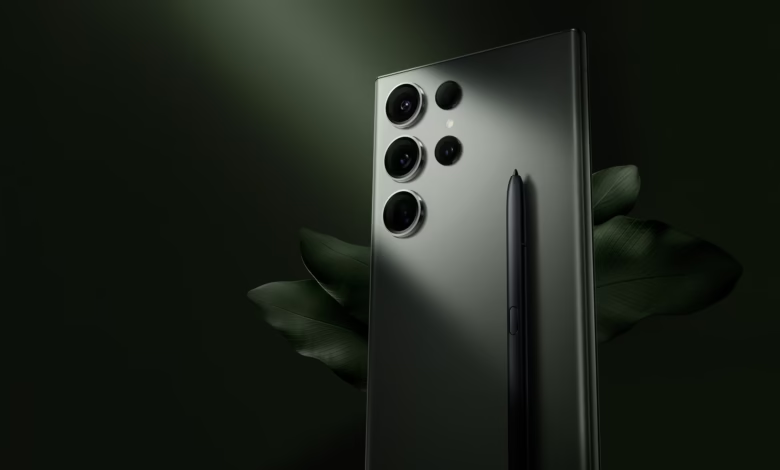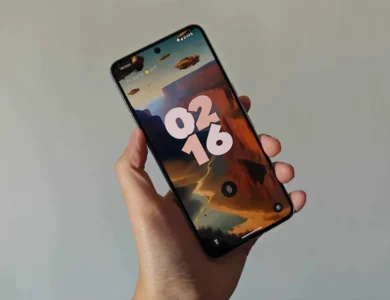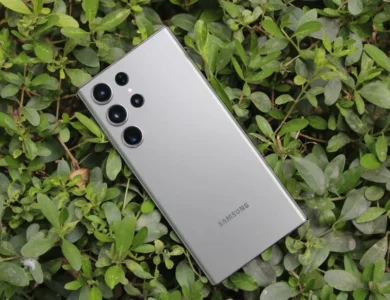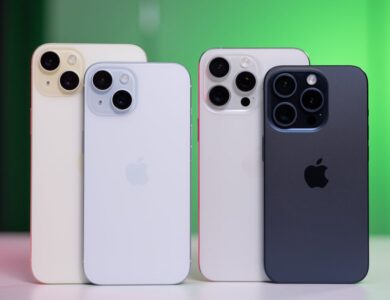
Pros
- Large, bright display
- Speedy performance
- Excellent cameras
- S Pen integration
- Solid battery life
- Durable hardware
- Strong software update commitment
Cons
- Expensive
- Big, heavy build
Samsung Galaxy S23 Ultra Specs
| Operating System | Android 13 |
| CPU | Qualcomm Snapdragon 8 Gen 2 for Galaxy |
| Dimensions | 6.43 by 3.07 by 0.35 inches |
The Galaxy S23 Ultra (starting at $1,199.99) carries the Galaxy Note torch forward as the lone smartphone in Samsung’s lineup to include the S Pen stylus. The company takes the kitchen-sink approach with the S23 Ultra; it has pretty much every feature a flagship phone shopper could want, including high-quality hardware, an outstanding display, blistering performance, and top-notch cameras. Its oversized footprint and price give us some pause, but many buyers are likely to look past these compromises for such a capable phone. If you don’t need the stylus or the extra cameras, the slightly smaller and more affordable Galaxy S23+ (starting at $999.99) might better serve you. But if you want it all, the Galaxy S23 Ultra is our Editors’ Choice winner for high-end Android phones.
Beautiful, But Big
The Galaxy S23 Ultra is the largest and most capable member of the S23 family, which also includes the S23+ ($999.99) and the S23 ($799.99). It stands apart from its less-expensive stablemates because of its squared-off design, built-in S Pen, and extra cameras.
The S23 Ultra takes many of its design cues from last year’s S22 Ultra. The phones are the exact same size at 6.43 by 3.07 by 0.35 inches (HWD), though the S23 Ultra weighs more at 8.25 ounces than the S22 Ultra (8.07 ounces). The Galaxy S23 (5.76 by 2.79 by 0.3 inches, 5.93 ounces) and Galaxy S23+ (6.21 by 3.0 by 0.3 inches, 6.91 ounces) are much smaller and lighter for comparison. There’s simply no denying the S23 Ultra is a massive piece of hardware. Slapping a case on it, which we recommend given the price tag, just adds to its size and weight.
The glass-and-metal sandwich design is common for today’s top devices and no company does it better than Samsung. The S23 Ultra features an Armor Aluminum frame that partially integrates recycled materials. Corning’s Gorilla Glass Victus 2 adds front and back protection against drops and scratches.
Samsung offers the phone in four main colors: Cream, Green, Lavender, and Phantom Black. If those don’t appeal, Samsung’s website offers exclusive colors such as Graphite, Lime, Red, and Sky Blue. Samsung says it uses recycled dyes to color the phones. The matte finish on the rear panel is appealing, as is the color-coordinated finish for the frame in between.

(Credit: Eric Zeman)
Speaking of the frame, it’s as pointy as ever. The sharp corners are a design feature I wish would go away. Cramming the phone into your pants pocket can be uncomfortable. Samsung did, however, reshape the metal along the phone’s side edges to make it a bit more rounded. The company also flattened out the display glass a little. The S22 Ultra had steeply curved side edges and a thin metal rail, but Samsung reduced the curvature by 30% for the S23 Ultra. Both changes improve the experience of holding the phone.
Samsung didn’t make significant changes to the camera module’s design. The Ultra’s four rear cameras and laser focusing array haven’t moved from the S22 Ultra, though the individual lenses are a touch larger. It’s a more attractive approach than Samsung took with previous models.

(Credit: Eric Zeman)
The phone meets the strict IP68 rating for protection from dust and water. It can survive a 30-minute dunk in up to 1.5 meters (about 5 feet) of water without worry. The Apple iPhone 14 Pro Max ($1,099) and the Google Pixel 7 Pro ($899) both share this same level of protection.
A few basic controls accent the frame. The power button and volume toggle are on the right side, along with a plastic cutout that covers the 5G antennas. Travel and feedback are excellent, though the power button is a bit small. The bottom of the phone is busy. From left to right, it houses the S Pen slot, a downward-firing speaker, a USB-C port, and a SIM card tray.

(Credit: Eric Zeman)
Samsung built a fingerprint reader into the display. I found it comfortable to reach, and it was a cinch to train and use. If you prefer facial recognition methods, a simple photo-based face ID tool sits above the screen. It’s not quite as fast as the fingerprint reader, nor is it as secure, but can be more convenient in certain circumstances (such as when you are wearing gloves).
In all, the Samsung Galaxy S23 Ultra might be too large for some buyers, but we can’t fault the otherwise top-notch hardware.
A Stunning Screen
The S23 Ultra has one of the best screens you can find on a smartphone. Though Samsung made only minimal improvements to the display compared with last year, it delivers an excellent experience just the same.

(Credit: Eric Zeman)
Samsung opts for a 6.8-inch Dynamic AMOLED 2X Infinity-O screen with an adaptive 120Hz refresh rate, which helps balance power and performance. The screen can dynamically alter its refresh rate from 1Hz up to 120Hz depending on the activity to conserve battery or enable smooth scrolling. It has QHD+ (3,088 by 1,440) resolution, for a pixel density of 501ppi. The Pixel 7 Pro actually has a slightly higher pixel density at 512ppi, whereas the iPhone 14 Pro Max’s is lower at 460ppi. The S23 and S23+ have 6.1- and 6.6-inch 120Hz displays, respectively, with FHD+ resolution (2,340 by 1,080 pixels).
The real upgrade is brightness. The screen puts out between 1,200 nits (typical) and 1,750 nits (peak outside). That’s dramatically better than the 1,200-nit max of last year’s S22 Ultra, though it falls short of the 1,600 nits (typical) and 2,000 nits (peak outside) of the iPhone 14 Pro Max. I held the S23 Ultra and the 14 Pro Max next to one another outside under direct sunlight and the iPhone does look slightly brighter, but not enough so to give it a serious competitive edge. Either way, the S23 Ultra’s display is easily visible under even the harshest lighting conditions.

(Credit: Eric Zeman)
Samsung allows for plenty of customization. First, you can alter the resolution between QHD+, FHD+, and HD+ depending on whether you want to see all the pixels or save power. You can also take advantage of adaptive brightness, blue light settings, color profiles, text and icon sizing, Samsung’s Edge panels (app shortcuts), the navigation bar (for gestures), touch sensitivity, and screen savers. Tweaking these leads to a more personalized experience.
The selfie camera interrupts the screen at the top, but the bezels between the display and the metal frame are so thin that they are practically nonexistent.
Display competition is tight at the top of the market, but the S23 Ultra impresses and performs well against its chief rivals.
S Pen Prowess
The S Pen stylus continues to clearly set the S23 Ultra apart from the S23 and S23+. The S Pen tucks into a slot on the lower edge of the phone on the left side. A gentle press pops out the stylus’ head, making it easy to grab and slide all the way out.

(Credit: Eric Zeman)
The S Pen is a smallish stylus. It has a slightly flat profile and a matte finish to help with grip. A utility button on one side enables a range of actions, such as advancing PowerPoint slides or triggering the camera shutter (this is really helpful). Samsung didn’t claim any improvements to the S Pen’s responsiveness this year. That said, it’s still the best stylus experience you’re going to get from a modern smartphone. It’s an incredibly fluid experience, and the small tip has a solid feel when you write on the glass.
The S23 Ultra carries over the same S Pen-focused software suite of the S22. That means features like Smart Select (for grabbing items off web pages), Translate (for selecting and translating text), S Pen to text (for transcribing), and Air Actions (for motion-based controls) are all available, with no new functionality.

(Credit: Samsung)
The one big update is tighter integration with Google apps on the S23 Ultra. Specifically, more text fields in Google apps such as Gmail, Chrome, and Maps support S Pen input. In practice, many of the text fields you might want to write in are small and require an extra tap to enable the feature. However, if you’re deep in stylus mode and don’t want to put the S Pen down to enter text in certain fields, this could be helpful. You won’t find a finer or more powerful stylus on any other phone.
Snapdragon for Galaxy = Ludicrous Speed
Samsung is among the first companies to ship a smartphone with the Qualcomm Snapdragon 8 Gen 2 processor. Perhaps more interestingly, Samsung worked with Qualcomm to tweak the CPU and GPU output of the chip and give it a competitive edge. It’s faster than the stock 8 Gen 2 and, as we expected, puts up huge scores on benchmarks.

(Credit: Eric Zeman)
The standard 8 Gen 2 is built on a 4nm process and includes an octa-core Kryo CPU with one Arm Cortex-X3 core at up to 3.2GHz, four performance cores at up to 2.8GHz, and three efficiency cores at up to 2.0GHz. The Snapdragon 8 Gen 2 for Galaxy boosts the top CPU clock speed to 3.36GHz. Qualcomm also upped the performance of the 8 Gen 2’s Adreno 740 GPU, but doesn’t say by how much.
The S23 Ultra benefits from more RAM than most other phones. The base model ships with 8GB of fast LPDDR5x RAM and 256GB of UFS 4.0 storage. But you can get the phone with up to 12GB of RAM as well as 512GB or 1TB of storage if you wish. We tested a model with 12GB of RAM and 512GB of storage ($1,379.99).
We ran the PCMark Web 3.0 benchmark, which covers the performance of web-based activities. The S23 Ultra notched 15,841 on the test, which compares favorably with the S22 Ultra (13,962) and the Pixel 7 Pro (11,369).
On Geekbench 5, which rates CPU performance, the S23 Ultra reached 1,545 on the single-core test and 5,078 on the multi-core test. That handily beats the scores of the S22 Ultra (1,232/3,433) and the Pixel 7 Pro (1,050/3,190), but not the Apple iPhone 14 Pro Max, which scored 1,874 and 5,445 on the same tests.
Next, we ran the 1440p Aztec Ruins GFXBench test, which covers graphics. The Galaxy S23 Ultra ran at 62 frames per second (fps), outperforming the S22 Ultra (60fps) and the iPhone 14 Pro Max (54fps).
Last, we ran Basemark Web 3.0. The S23 Ultra scored 925, crushing the S22 Ultra (552) and the Pixel 7 Pro (466). None of these came close to the iPhone 14 Pro Max’s score of 1,136, however.

(Credit: Basemark, PCMark, Geekbench)
The bottom line here is that the S23 Ultra performs at the top of the Android class, and surpasses Apple’s best in terms of GPU performance, though it falls a bit short of the iPhone’s CPU speeds. It’s worth noting that the S23 and S23+ top out at 8GB of RAM, so it’s possible their benchmark scores are slightly slower even though they have the same Snapdragon 8 Gen 2 for Galaxy SoC.
What matters more than all these numbers, of course, is how the phone does in the real world. We tested the S23 Ultra against a wide array of apps, including some hard-hitting games like Genshin Impact. Running the game at the highest settings resulted in excellent gameplay without any lag or frame drops. Given the huge storage options and flexible screen settings, the phone is an excellent companion for mobile gaming.
Making the Connection
The S23 Ultra is one of the first devices to include the Qualcomm Snapdragon X70 modem. The modem works hand-in-hand with the 8 Gen 2 SoC to manage 5G, Wi-Fi, and other connections to ensure the best possible performance.

(Credit: Eric Zeman)
The modem adds support for several new 5G bands that the S22 Ultra didn’t support, chiefly mid-band spectrum for AT&T, T-Mobile, and Verizon. In the US, AT&T customers will see the biggest performance jump compared with the previous generation.
We ran our tests on T-Mobile’s network in New Jersey. In areas with strong T-Mobile 5G coverage (signaled by the UC, or Ultra Capacity, in the signal bar), we saw maximum download speeds of 180Mbps and maximum upload speeds of 79Mbps. When we tested in areas with weak T-Mobile coverage, download and upload speeds dropped to maximums of 19Mbps and 8Mbps, respectively. Whether the signal was strong or weak, however, we were always able to connect calls on the first attempt and didn’t experience any drops during testing.
The phone supports Wi-Fi 6E, which is the latest standard available to consumer devices. We noticed the speed difference when we tested the S23 Ultra against competitors. I held the phone about a foot from a Verizon Fios router with 940Mbps service and saw a peak download speed of 609Mbps, which is significantly faster than the Pixel 7 Pro’s 475Mbps and the iPhone 14 Max Pro’s 435Mbps peak download speeds. The S23 Ultra also outperformed its peers at the Wi-Fi network’s edge. Where the iPhone and Pixel peaked at 3.47Mbps and 3.62Mbps, respectively, the S23 Ultra was faster with a top download speed of 6.35Mbps. In terms of real-world performance, the phone downloaded apps and games larger than 1GB in less than a minute in most instances. The phone had no trouble browsing the web even on congested Wi-Fi networks.
Bluetooth support notches up to version 5.3. This is the newest spec for phones and makes it possible to maintain more consistent connections while using less power. We paired the S23 Ultra with several accessories and didn’t run into any trouble. It supports advanced audio codecs including AAC and AptX; music sounded outstanding through the Sony WH-1000XM5 headphones.
The S23 doesn’t introduce satellite messaging, as was widely expected. The iPhone 14 Pro Max might be a better option if you spend a lot of time off the grid and want a backup emergency SOS option. (Though, at least the Galaxy S23 Ultra won’t randomly call 911 while you’re on a roller coaster.)

(Credit: Eric Zeman)
What are phone calls like? Excellent. The phone has a strong earpiece that puts out clear sound. You can make HD voice calls (depending on network support) as well as Wi-Fi calls; both are great. I was able to hear callers even in moderately loud environments such as subway platforms, and those with whom I spoke had no trouble understanding me.
If you’re interested in playing music directly through the phone rather than wireless headphones, the downward-firing speaker and earpiece work together to create stereo sound. Sound output is generally good and has a fairly rounded profile. We tested several tracks, including The Knife’s “Silent Shout,” and enjoyed the mix. The phone won’t replace a Bluetooth speaker, but it does just fine for listening in an average room by yourself.
Same Battery, Longer Life
The Galaxy S23 Ultra has the same 5,000mAh battery as last year’s S22 Ultra. Despite the unchanged capacity, the 2023 phone manages to outlast the 2022 model, though not by much.

(Credit: Eric Zeman)
In our battery life test, which entails playing a YouTube video on loop over Wi-Fi with the phone’s brightness set to the max, the S23 Ultra lasted 13 hours and 11 minutes. That’s a nice uptick from the 12 hours and 14 minutes of the S22 Ultra and the 10 hours and 30 minutes of the Pixel 7 Pro, though well short of the 19-hour mark of the iPhone 14 Pro Max.
How did Samsung manage to get better battery life despite the same battery capacity and a brighter screen? The Snapdragon 8 Gen 2 likely plays a role here, as it’s able to complete computing tasks more efficiently than the S22 Ultra’s 8 Gen 1 SoC.
In more anecdotal terms, the S23 Ultra easily plowed through a full day of intense use with plenty of charge left in the tank. I would expect most people to see 1.5 days of battery life with average use.
The phone doesn’t charge any faster than the previous version. It supports the same 45W wired and 15W wireless charging rates as the S22 Ultra. The phone doesn’t ship with a charger, either, so you have to provide one. We tested it with both a 45W charger and a 25W charger and saw charging times of 71 minutes and 81 minutes, respectively. That’s faster than an iPhone 14 Pro Max will charge (90 minutes), but not as fast as the OnePlus 11 5G (27 minutes).
Pixel Challenger
Samsung generally reserves its best camera technology for the Galaxy S series, and the S23 Ultra takes things to a new level. The phone has a bevy of cameras (five!) that take photos as good as—and sometimes better than—the Apple iPhone 14 Pro Max and the Google Pixel 7 Pro.

(Credit: Eric Zeman)
Last year’s Galaxy S22 Ultra featured a 108MP ISOCELL HP1 sensor. This year, Samsung upgraded the S23 Ultra to a 200MP ISOCELL HP2 sensor. The 200 million pixels are packed onto a 1/1.3-inch chip, each measuring 0.6μm. The phone shoots at 12.5MP out of the box, binning pixels down by a factor of 16 to 1. You can opt to take 50MP photos or 200MP photos if you wish. These offer more information for finer detail, but potentially more noise. The main lens has an aperture of f/1.7 and benefits from both optical image stabilization (OIS) and laser autofocus. Samsung says it enlarged the area in which the sensor can travel during phone movement to account for a greater range of stabilization. In other words, you should get better shots when your hands are shaky compared with the S22 Ultra.
Beyond this main shooter, the S23 Ultra also has a 12MP ultra-wide camera at f/2.2, a 10MP 3x telephoto with OIS at f/2.4, a periscopic 10MP 10x telephoto at f/4.9, and a 12MP selfie camera with phase-detect autofocus at f/2.2. While the three additional rear cameras are basically carryovers from the S22 Ultra, the new selfie camera is a significant upgrade over the 40MP shooter on last year’s model.
The new sensor, together with the Snapdragon 8 Gen 2, powers several shooting modes such as Adaptive Pixel, Auto Framing, Director’s View, High-Resolution Photo, Multi-Exposure, Nightography, Selfie Night Portrait, and Super HDR. There are also basics including slow motion, hyper lapse, panorama, and food. If you really want to get fancy, you can use the Pro mode to take full control of aspects like shutter speed, exposure, and ISO, as well as Expert Raw to shoot photos with more detail for advanced editing in post.
How do the photos look? Outstanding. We captured shots in various environs and lighting conditions and, suffice it to say, the pictures look quite good. The camera is a small step up from the S22 Ultra, and about on par with the iPhone 14 Pro Max and the Pixel 7 Pro. The best one for you depends a bit on what you want from your phone. The Galaxy boosts colors but shows excellent exposure and HDR. The iPhone takes warmer photos that are sometimes a little softer. The Pixel takes a more natural approach to color but is often better with highlights and details. Here are a handful of samples:

Main camera, sunny skies (Credit: Eric Zeman)

Main camera, mixed lighting (Credit: Eric Zeman)

Main camera, dark lighting (Credit: Eric Zeman)

2x optical zoom (Credit: Eric Zeman)

3x optical zoom (Credit: Eric Zeman)

30x Space Zoom (Credit: Eric Zeman)

Selfie camera, portrait (Credit: Eric Zeman)
The spec improvements also mean the S23 Ultra is better at recording video. Although your best bet for everyday shooting is likely still 4K60, the phone can capture 4K60 in HDR, as well as 8K24 and 8K30. The latter two are options only for the main camera at 1x zoom, but all the other resolutions and frame rates are available to each of the other cameras.
The video footage I captured looked excellent. The 4K60 HDR video really shines on the S23 Ultra’s display and a high-quality TV. The expanded OIS features of the phone are helpful, though not quite as good as the iPhone 14’s Action Mode when it comes to stabilization. Still, the S23 Ultra is among the best at capturing video in the Android landscape.
Android at Its Second Best
The Galaxy S23 Ultra ships with Android 13 and Samsung’s One UI 5.1 user interface. Android 13 is a fine base layer for the S23 Ultra. Samsung has slathered its own software on top, which means Android 13 on the S23 Ultra doesn’t look the same as Android 13 on Google’s Pixel 7 Pro.

Samsung One UI 5 (Credit: Samsung)
Not much is new here for the S23 Ultra, other than minor tweaks to the phone’s customization options. For example, there’s a fresh widget system for the home screen as well as a new video lock screen option. There are a handful of new modes and routines that you can toggle depending on where you are or what time of day it is. This is helpful, for instance, if you need to focus on work. Samsung also overhauled the Bixby Text Call feature, making it easier to generate text-to-audio responses for incoming phone calls. Last, Samsung tightened the screws around its Knox security suite, which is more enterprise-friendly than ever.
There’s no question Samsung’s software is powerful, though it can be overwhelming. You might prefer the simpler functionality of Google’s or Motorola’s versions of Android, but you cannot deny the vast array of features available from the S23 Ultra and One UI 5.
What will impact S23 Ultra owners the most, however, is Samsung’s commitment to system and security updates. The company promises four operating system upgrades (to Android 17) as well as five years of security updates. This is better than Google’s promise to Pixel phones, which only get three OS upgrades.
Last, Samsung ensured that all three of its new Galaxy phones integrate closely with its latest Galaxy Book laptops. A range of features allows Samsung’s phones and laptops to talk to one another for things such as copying and pasting text, syncing web browser history and passwords, seamlessly connecting via mobile hotspot, and sending text messages from your laptop.

(Credit: Eric Zeman)
A Clear Winner
The Samsung Galaxy S23 Ultra is an excellent choice if you want the best of the best. The phone has an outstanding display, some of the fastest performance we’ve seen, a long-lasting battery, powerful software with S Pen stylus integration, and a top-notch set of cameras. It’s a gigantic phone, however, and might not suit users with smaller hands (or pockets). Moreover, with a starting price of $1,199.99, it might also be out of reach financially. The Pixel 7 Pro saves you $300 (though you lose the S Pen), while the iPhone 14 Pro Max saves you only $100 (and you have to adopt iOS). The Galaxy S23 and S23+, meanwhile, offer many of the same features as the Ultra in smaller, less-expensive bodies. But if you truly want it all, the Galaxy S23 Ultra wins our Editors’ Choice award.


